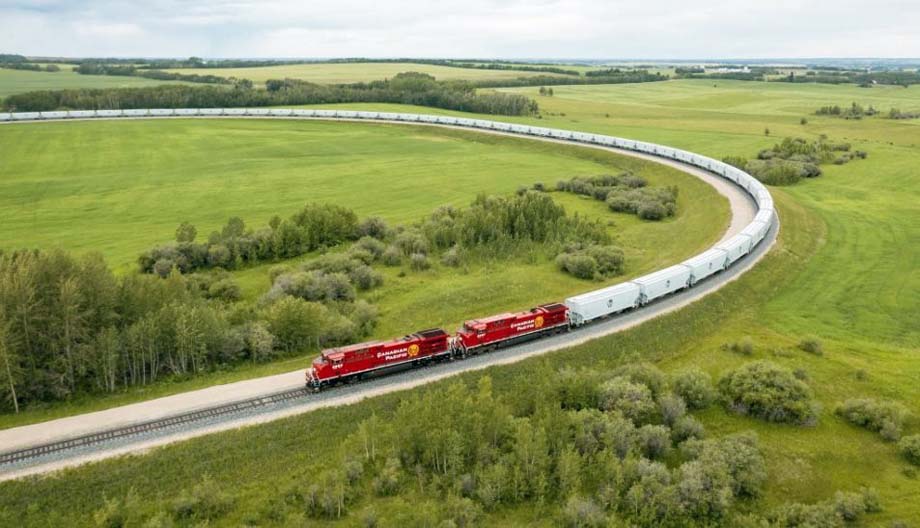
Canada - In the history of Prairie grain farming, a headline saying farmers are happy with the
railways is not seen often, but it's apt for this crop year.
CN recently announced a record-setting February in which it moved more than 2.4 million tonnes of grain from Western
Canada that month.
CP had similar reasons to boast, moving 2.3 million tonnes of grain and grain products in January, nearly double what
it managed in January 2022.
"This year so far it's been running smoothly overall.
There's been a few delays, I had to wait a week to make a grain shipment. I can live with that as a farmer," said
Dave Bishop, director at large with the Alberta Wheat Commission.
Although some might argue that a relatively mild winter is largely responsible, Bishop is willing to give credit where
credit is due.
"I know the railway gets blamed for a lot of stuff, and they rightfully should because they do have a lot of
issues, but it's not always their fault," he said.
"There's lots of issues at the port that backlog everything down the supply line. If it's raining in Vancouver you
can't load a vessel. If there's some issues with some ships getting in, they can't load the vessels."
Shane Strydhorst, zone three director with Alberta Pulse Growers, also gave the railway companies a tip of the hat for
keeping pulses moving this winter.
"I've talked to a number of different farmers in the province and I think everyone is pretty happy with the
movement we've had this winter. It's been a great improvement. We had a much larger crop last year than the year
before. We needed a lot better movement, and we certainly got much better movement this crop year than what we got in
the 2021-2022 crop year. A great deal of tonnage has been moved and it's been on time and in some cases early, which
has made a lot of people very happy."
Strydhorst believes the railway companies are taking producer criticisms to heart and are making efforts to improve
their services.
"That, coupled with generally fairly good weather throughout the winter, has allowed for a lot better
movement," he said.
Better Communication
Communication between farmers and the railways has also improved, said Bishop, who serves on CN's ag advisory council,
comprised of Prairie producers who express concerns and how they can be addressed.
"We sit down and help them with the grain plan to some extent, reviewing it and writing it up. They have
conversations with us and ask our opinions on things. So the communication over the last few years, especially with CN,
has been a lot better. Before, we used to know nothing. There was no communication," he said.
"CP is not as good at communicating as CN, but they are better than they used to be. So I think you're seeing a
lot more of this communication happening back and forth. That's very encouraging."
CN acknowledged this new era of co-operation in a March news release, noting increased collaboration between supply
chain partners that has enabled strong performance through operational challenges, including periods of extreme
cold.
"Improved communications between CN, our customers and supply chain partners have made our grain supply chain a
success in February," said Sandra Ellis, vice-president, bulk with Rail Centric Supply Chain, CN.
"When each of us has a better understanding of what our partners are dealing with, we can adjust our individual
operations to work through disruptions when they occur."
More Hoppers
Some systemic issues remain, said Strydhorst.
"Quite often the demand for cars isn't being met, which of course leads to shipping delays and some inefficiencies
and increased costs for everyone."
This is a matter CP is working on, said Jean Hardy, vice-president of sales and marketing, grains and fertilizers, in a
release.
"We have invested more than $500 million in new high-capacity hopper cars and we are working with our customers to
boost supply chain capacity."
A bigger problem from a pulse perspective is the cost of shipping containers.
Thirty to 40 percent of pulse crops are shipped in these, said Strydhorst, with green lentils and chickpeas almost
exclusively shipped this way.
"Container shipping is still quite expensive and has been quite inconsistent over the winter," he
said.
"I think it's improved a little bit since November and December but there's still quite a bit of inconsistency
there, which is a struggle."
Although not a railroad responsibility, holdups at the Port of Vancouver continue to be a headache for producers
seeking timely delivery of their products.
"One thing I've heard this winter more than in the past is about rain causing delays for loading ships," said
Strydhorst.
"That's something I hope will be addressed, upgrading our ports to have more consistent loading because if we
can't deliver our product consistently and reliably, it's just one more risk for our system."
One boon to farmers in recent years has been the advent of high-throughput terminals equipped with loop tracks such as
those developed by G3 and others.
"You can take a whole unit train going to one location, fill it and leave, whereas with other elevators, they drop
cars off, pick some up, and drop some off. It takes time to do," said Bishop.
"These circle tracks on these new inland terminals are way more efficient."
But they're not a magic bullet for the industry's transportation woes.
They're expensive and many conventional grain terminals can't adapt to the loop tracks, he said.
"The only way you're going to get one is if you're building a new one, basically because most of the elevators
don't have the room to put in a circle track."
Jeff Melchior.
(likely no image with original article)
(usually because it's been seen before)
provisions in Section 29 of the Canadian
Copyright Modernization Act.
